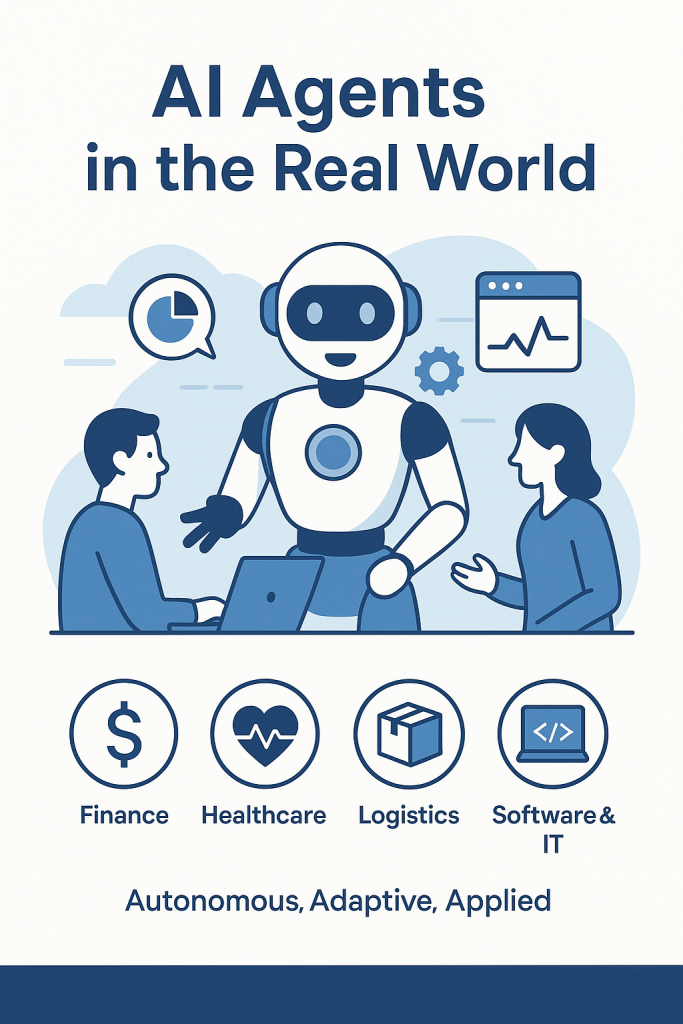
What Defines an AI Agent?
An AI agent is an autonomous software entity capable of perceiving its environment, making decisions, and acting to achieve specific goals—often with minimal human oversight. Unlike traditional automation, which follows rigid scripts, AI agents operate with contextual awareness and adaptive reasoning.
“An agent is anything that can be viewed as perceiving its environment through sensors and acting upon that environment through actuators.”
— Stuart Russell & Peter Norvig, Artificial Intelligence: A Modern Approach (4th Edition, 2020)
- Customer Service: Chatbots that resolve support tickets end-to-end (e.g., Intercom Fin, Ada).
- Logistics: Autonomous warehouse robots optimizing fulfillment (Amazon Robotics).
- Workflows: Agents orchestrating multi-step tasks (AutoGen, CrewAI).
Core Technologies Enabling Modern AI Agents
Most modern agents leverage Large Language Models (LLMs) as reasoning engines. Tools like
LangChain,
AutoGen, and
CrewAI provide orchestration frameworks, allowing agents to call APIs, access databases, and work together to solve problems.
- API Integration: Connecting LLMs to real-world tools (e.g., Slack, CRMs, databases).
- Retrieval-Augmented Generation (RAG): Ensuring agents use current, relevant data instead of hallucinating.
- Reinforcement Learning: Allowing agents to improve strategies over time.
Open-source libraries like
Hugging Face Transformers and hosted services like
OpenAI API lower the barrier for adoption.
Industry Use Cases
Finance
- JP Morgan’s IndexGPT is designed to generate investment insights autonomously, streamlining asset management
(CNBC). - Morgan Stanley deploys GPT-4-based assistants for compliance and internal research.
Healthcare
- Mayo Clinic’s AI triage agent pilots patient intake, reducing time spent by clinicians.
- Babylon Health uses AI to conduct preliminary consultations and symptom checks.
Retail & Logistics
- Amazon uses Kiva robots for inventory picking and route optimization.
- Instacart’s AI ordering agent predicts shopping lists and automates reorders.
Software & IT
- GitHub Copilot acts as a coding partner, auto-suggesting code and reviewing pull requests.
- Incident response bots detect anomalies, open tickets, and recommend remediation steps
(PagerDuty,
Datadog).
Deployment Challenges and Lessons Learned
- Data Privacy: Agents must comply with regulations (GDPR, HIPAA) when accessing sensitive data.
- Hallucinations: LLMs may fabricate plausible but false information—constant monitoring is essential.
- Human-in-the-Loop: Critical for high-stakes decisions; automation should augment, not replace, oversight.
- Security and Reliability: Agents can introduce new attack surfaces. Microsoft, for example, outlines responsible Copilot deployment with robust monitoring and fallback protocols
(Microsoft Responsible AI Guidelines).
Toolchain and Implementation Guide
- Select a Framework: LangChain and AutoGen for LLM-based agents, CrewAI for multi-agent workflows.
- Integrate APIs: Ensure agents can interact with required tools (databases, messaging, proprietary systems).
- Develop and Test: Pilot with open-source models (Llama 3, Mistral) before committing to paid APIs.
- Deploy Securely: Isolate agent actions, log everything, implement human-override capabilities.
- Monitor and Iterate: Use dashboards for performance and incident tracking; retrain agents as needs evolve.
Open-source stacks enable fast prototyping. For enterprise scale, managed services from Microsoft, Google, or OpenAI ensure uptime and compliance.
The Road Ahead—Trends and Implications
- Multimodal agents will combine vision, speech, and structured data (see OpenAI GPT-4o and Google’s Project Astra).
- Agent swarms—collaborative, specialized agents—promise fully autonomous workflows
(AutoGen, CrewAI). - Workforce impact: Routine work is increasingly automated, shifting demand toward oversight, prompt engineering, and AI maintenance.
Adoption requires not just technical investment, but continuous evaluation of outcomes and risks.
Takeaways and Next Steps
- Identify clear business problems. Agents work best with well-scoped, repetitive, or data-rich tasks.
- Start small and measure outcomes. Pilot before scaling; track KPIs.
- Stay current on security and compliance. Regulatory risk can derail projects.
- Invest in human capital. Train staff to monitor and refine agent behavior.
Autonomous AI is no longer a future promise. For organizations that move decisively, AI agents represent a practical pathway to greater efficiency and new competitive advantage.